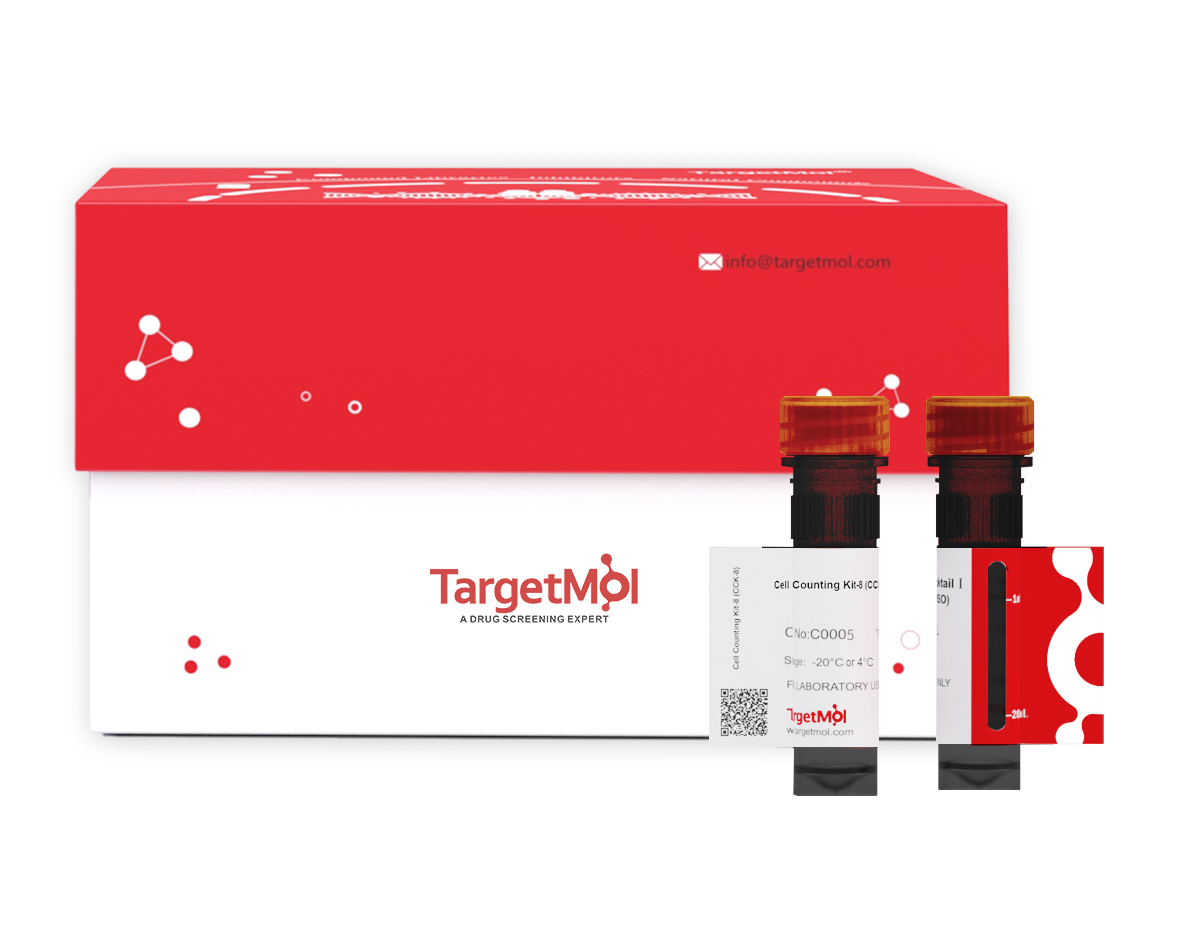

Cell Counting Kit-8 (CCK-8) allows very convenient assays by utilizing the highly water-soluble tetrazolium salt WST-8 [2-(2-methoxy-4-nitrophenyl)-3-(4-nitrophenyl)-5-(2,4-disulfophenyl)-2H-tetrazolium,monosodium salt] produces a water-soluble formazan dye upon reduction in the presence of an electron carrier. Cell Counting Kit-8 is a one-bottle solution; no premixing of components is required. Cell Counting Kit- 8, being nonradioactive, allows sensitive colorimetric assays for the determination of the number of viable cells in cell proliferation and cytotoxicity assays.

| Pack Size | Availability | Price/USD | Quantity |
|---|---|---|---|
| 1 mL (100 tests) | In stock | $ 19.00 | |
| 5 mL (500 tests) | In stock | $ 48.00 | |
| 10 mL (1000 tests) | In stock | $ 79.00 | |
| 30 mL (3000 tests) | In stock | $ 184.00 | |
| 100 mL (10000 tests) | In stock | $ 547.00 |
WST-8 is reduced by dehydrogenases in cells to give a yellowcolored product (formazan), which is soluble in the tissue culture medium. The amount of the formazan dye generated by the activity of dehydrogenases in cells is directly proportional to the number of living cells. The detection sensitivity of CCK-8 is higher than other tetrazolium salts such as MTT, XTT, MTS or WST-1.
| Properties | MTT | XTT | WST-1 | CCK8 |
|---|---|---|---|---|
| Solublity of formazan | - | + | + | + |
| Forms | Powder | 2-bottle solution | 1-bottle solution | 1-bottle solution |
| Preparation | Dissolve before use | Mix before use | Ready to use | Ready to use |
| Sensitivity | + | ++ | ++ | +++ |
| Detection Speed | + | ++ | ++ | +++ |
| Wavelerngth | 560~600nM | 420~480nM | 420~480nM | 430~490nM |
| Toxicity | + | - | - | - |
| Stability | + | - | + | ++ |
| 96-well plate compatibility | + | ++ | ++ | ++ |
| Convenience | + | ++ | ++ | +++ |
1. 100μL cell suspension was inoculated on 96-well plate and incubated in cell incubator (37°C, 5% CO2). 2. Take the cells out of the incubator ,add 1/10 volume of Cell Counting Kit-8 (CCK-8) directly to cells in culture medium. Mix thoroughly to achieve a homogenous solution by lightly tapping the outside of the plate several times while avoiding bubbles. For 96-well plate, add 10 µl Cell Counting Kit-8 (CCK-8) per 100 µl culture medium. 3. Incubate in a cell culture incubator for 1 to 4 hours at 37°C until the color turns orange. Over incubation will give false results. 4. Place the 96-well plate on the shaking table for about 1min before the reading of the micrometer to ensure the uniform color of orifice plate. 5. The 450nm light absorption value was read by an enzyme marker and cell activity was calculated. 6. Optional: Add 10 μl of 1 % SDS (dissolve 0.1 g SDS with PBS buffer to prepare 10 ml solution) directly to 100 μl of cells to stop the reaction. Signals can be read within 3 days without affecting the absorbance values.
The Cell Counting Kit-8 (CCK-8) is stable for 1 year at 4°C with protection from light. For long term storage, store at -20°C and below.
